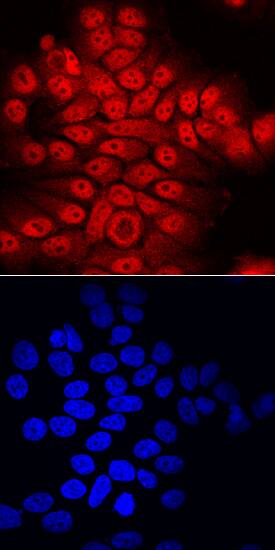Human ATBF1/ZFHX3 Antibody
R&D Systems, part of Bio-Techne | Catalog # AF7384

Key Product Details
Species Reactivity
Validated:
Cited:
Applications
Validated:
Cited:
Label
Antibody Source
Product Specifications
Immunogen
His3608-Leu3703
Accession # Q15911
Specificity
Clonality
Host
Isotype
Scientific Data Images for Human ATBF1/ZFHX3 Antibody
ATBF1/ZFHX3 in MCF‑7 Human Cell Line.
ATBF1/ZFHX3 was detected in immersion fixed MCF-7 human breast cancer cell line using Sheep Anti-Human ATBF1/ZFHX3 Antigen Affinity-purified Polyclonal Antibody (Catalog # AF7384) at 10 µg/mL for 3 hours at room temperature. Cells were stained using the NorthernLights™ 557-conjugated Anti-Sheep IgG Secondary Antibody (red, upper panel; Catalog # NL010) and counterstained with DAPI (blue, lower panel). Specific staining was localized to nuclei and cytoplasm. View our protocol for Fluorescent ICC Staining of Cells on Coverslips.Applications for Human ATBF1/ZFHX3 Antibody
Immunocytochemistry
Sample: Immersion fixed MCF-7 human breast cancer cell line
Formulation, Preparation, and Storage
Purification
Reconstitution
Formulation
Shipping
Stability & Storage
- 12 months from date of receipt, -20 to -70 °C as supplied.
- 1 month, 2 to 8 °C under sterile conditions after reconstitution.
- 6 months, -20 to -70 °C under sterile conditions after reconstitution.
Background: ATBF1/ZFHX3
ATBF1 (Adenine-Thymine motif Binding Factor 1; also ZFHX3) is a 400 kDa highly modular protein that contains motifs found in multiple transcription factor families. It is expressed by a variety of cells, both normal and malignant, including postmitotic neurons, hepatocytes, mammary epithelium and gastric carcinoma cells. ATBF1 is both cytoplasmic and nuclear, and its localization has pronounced effects on the cell cycle. Cytoplasmic ATBF1 is associated with cell proliferation, while nuclear ATBF1 appears to promote cell differentiation. Human ATBF1-A is 3703 amino acids (aa) in length. It contains seventeen consecutive C2H2-type Zn finger domains interspersed with short poly-Glu and poly-Ala segments (aa 282-2006), followed by two homeobox domains (aa 2146-2301), two additional C2H2 Zn finger domains (aa 2328-2552) and two homeobox plus three intermixed Zn finger domains. There are at least six utilized Ser phosphorylation sites. Two isoform variants have been reported. The first is termed ATBF1-B. It has a predicted MW of 306 kDa and appears following the use of an alternative start site at Met915. When the 914 aa N‑terminus is present (as in ATBF1-A), ATBF1 shows transcriptional repression; when it is absent (as in ATBF1-B), ATBF1 acts as a transcriptional activator. The second isoform variant contains a 41 aa substitution for aa 1150-3703. Over aa 3608-3703, human ATBF1 shares 98% aa sequence identity with mouse ATBF1.
Alternate Names
Gene Symbol
UniProt
Additional ATBF1/ZFHX3 Products
Product Documents for Human ATBF1/ZFHX3 Antibody
Product Specific Notices for Human ATBF1/ZFHX3 Antibody
For research use only
